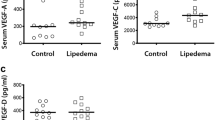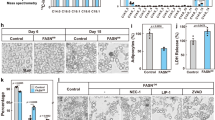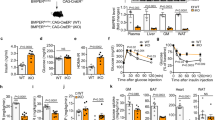Abstract
Lipoedema is associated with widespread adipose tissue expansion, particularly in the proximal extremities. The mechanisms that drive the development of lipoedema are unclear. In this Perspective article, we propose a new model for the pathophysiology of lipoedema. We suggest that lipoedema is an oestrogen-dependent disorder of adipose tissue, which is triggered by a dysfunction of caveolin 1 (CAV1) and subsequent uncoupling of feedback mechanisms between CAV1, the matrix metalloproteinase MMP14 and oestrogen receptors. In addition, reduced CAV1 activity also leads to the activation of ERα and impaired regulation of the lymphatic system through the transcription factor prospero homeobox 1 (PROX1). The resulting upregulation of these factors could effectively explain the main known features of lipoedema, such as adipose hypertrophy, dysfunction of blood and lymphatic vessels, the overall oestrogen dependence and the associated sexual dimorphism, and the mechanical compliance of adipose tissue.
This is a preview of subscription content, access via your institution
Access options
Access Nature and 54 other Nature Portfolio journals
Get Nature+, our best-value online-access subscription
$29.99 / 30 days
cancel any time
Subscribe to this journal
Receive 12 print issues and online access
$209.00 per year
only $17.42 per issue
Buy this article
- Purchase on Springer Link
- Instant access to full article PDF
Prices may be subject to local taxes which are calculated during checkout


Similar content being viewed by others
References
Szél, E., Kemény, L., Groma, G. & Szolnoky, G. Pathophysiological dilemmas of lipedema. Med. Hypotheses 83, 599–606 (2014).
Child, A. H. et al. Lipedema: an inherited condition. Am. J. Med. Genet. Part A 152, 970–976 (2010).
Warren, A. G., Janz, B. A., Borud, L. J. & Slavin, S. A. Evaluation and management of the fat leg syndrome. Plast. Reconst. Surg. 119, 9e–15e (2007).
Suga, H. et al. Adipose tissue remodeling in lipedema: adipocyte death and concurrent regeneration. J. Cutan. Pathol. 36, 1293–1298 (2009).
Li, X. et al. The critical role of MMP14 in adipose tissue remodeling during obesity. Mol. Cell. Biol. 40, e00564-19 (2020).
Sun, K. et al. Endotrophin triggers adipose tissue fibrosis and metabolic dysfunction. Nat. Commun. 5, 3485 (2014).
Bu, D. et al. Human endotrophin as a driver of malignant tumor growth. JCI Insight 4, e125094 (2019).
Chun, T. H. et al. Genetic link between obesity and MMP14-dependent adipogenic collagen turnover. Diabetes 59, 2484–2494 (2010).
Sounni, N. E. et al. Stromal regulation of vessel stability by MMP14 and TGFβ. Dis. Model. Mech. 3, 317–332 (2010).
Chun, T. H. Peri-adipocyte ECM remodeling in obesity and adipose tissue fibrosis. Adipocyte 1, 89–95 (2012).
Chun, T. H. et al. A pericellular collagenase directs the 3-dimensional development of white adipose tissue. Cell 125, 577–591 (2006).
Annabi, B. et al. Localization of membrane-type 1 matrix metalloproteinase in caveolae membrane domains. Biochem. J. 353, 547–553 (2001).
Puyraimond, A., Fridman, R., Lemesle, M., Arbeille, B. & Menashi, S. MMP-2 colocalizes with caveolae on the surface of endothelial cells. Exp. Cell Res. 262, 28–36 (2001).
Aga, M. et al. Differential effects of caveolin-1 and -2 knockdown on aqueous outflow and altered extracellular matrix turnover in caveolin-silenced trabecular meshwork cells. Invest. Ophthalmol. Vis. Sci. 55, 5497–5509 (2014).
Kruglikov, I. L. & Scherer, P. E. Caveolin-1 as a pathophysiological factor and target in psoriasis. NPJ Aging Mech. Dis. 5, 4 (2019).
Kruglikov, I. L. & Scherer, P. E. Caveolin-1 as a target in prevention and treatment of hypertrophic scarring. NPJ Regen. Med. 4, 9 (2019).
Kruglikov, I. L., Zhang, Z. & Scherer, P. E. Caveolin-1 in skin aging — from innocent bystander to major contributor. Ageing Res. Rev. 55, 100959 (2019).
Kruglikov, I. L. & Scherer, P. E. Caveolin-1 as a possible target in treatment for acne. Exp. Dermatol. 29, 177–183 (2019).
Kruglikov, I. L. & Scherer, P. E. Caveolin as a universal target in dermatology. Int. J. Mol. Sci. 21, 80 (2020).
Kim, H. N. & Chung, H. S. Caveolin-1 inhibits membrane-type 1 matrix metalloproteinase activity. BMB Rep. 41, 858–862 (2008).
Labrecque, L. et al. Src-mediated tyrosine phosphorylation of caveolin-1 induces its association with membrane type 1 matrix metalloproteinase. J. Biol. Chem. 279, 52132–52140 (2004).
Deng, J. et al. Overexpression of Prox1 induces the differentiation of human adipose-derived stem cells into lymphatic endothelial-like cells in vitro. Cell. Reprogram 19, 54–63 (2017).
Gramolelli, S. et al. PROX1 is a transcriptional regulator of MMP14. Sci. Rep. 8, 1–13 (2018).
Escobedo, N. & Oliver, G. The lymphatic vasculature: its role in adipose metabolism and obesity. Cell Metab. 26, 598–609 (2017).
Ragusa, S. et al. Antiangiogenic immunotherapy suppresses desmoplastic and chemoresistant intestinal tumors in mice. J. Clin. Invest. 130, 1199–1216 (2020).
Harvey, N. L. et al. Lymphatic vascular defects promoted by Prox1 haploinsufficiency cause adult-onset obesity. Nat. Genet. 37, 1072–1081 (2005).
Escobedo, N. et al. Restoration of lymphatic function rescues obesity in Prox1-haploinsufficient mice. JCI Insight 1, e85096 (2016).
Nores, G. G. et al. Obesity but not high-fat diet impairs lymphatic function. Int. J. Obes. 40, 1582–1590 (2016).
Nitti, M. D. et al. Obesity-induced lymphatic dysfunction is reversible with weight loss. J. Physiol. 594, 7073–7087 (2016).
Khan, T. et al. Metabolic dysregulation and adipose tissue fibrosis: role of collagen VI. Mol. Cell. Biol. 29, 1575–1591 (2009).
Divoux, A. et al. Fibrosis in human adipose tissue: composition, distribution, and link with lipid metabolism and fat mass loss. Diabetes 59, 2817–2825 (2010).
Alkhouli, N. et al. The mechanical properties of human adipose tissues and their relationships to the structure and composition of the extracellular matrix. Am. J. Physiol. Endocrinol. Metab. 305, E1427–E1435 (2013).
Sun, K., Tordjman, J., Clément, K. & Scherer, P. E. Fibrosis and adipose tissue dysfunction. Cell Metab. 18, 470–477 (2013).
Lackey, D. E. et al. Contributions of adipose tissue architectural and tensile properties toward defining healthy and unhealthy obesity. Am. J. Physiol. Endocrinol. Metab. 306, E233–E246 (2014).
Park, J. & Scherer, P. E. Adipocyte-derived endotrophin promotes malignant tumor progression. J. Clin. Invest. 122, 4243–4256 (2012).
Comley, K. & Fleck, N. A. A micromechanical model for the Young’s modulus of adipose tissue. Int. J. Solids Struct. 47, 2982–2990 (2010).
Kruglikov, I. L. General theory of body contouring: 2. Modulation of mechanical properties of subcutaneous fat tissue. J. Cosmet. Dermatol. Sci. Appl. 4, 117–127 (2014).
Chang, E., Varghese, M. & Singer, K. Gender and sex differences in adipose tissue. Curr. Diab. Rep. 18, 69 (2018).
Pasarica, M. et al. Adipose tissue collagen VI in obesity. J. Clin. Endocrinol. Metab. 94, 5155–5162 (2009).
Davis, K. E. et al. The sexually dimorphic role of adipose and adipocyte estrogen receptors in modulating adipose tissue expansion, inflammation, and fibrosis. Mol. Metab. 2, 227–242 (2013).
Zhang, X. et al. Caveolin-1 down-regulation activates estrogen receptor alpha expression and leads to 17β-estradiol-stimulated mammary tumorigenesis. Anticancer Res. 25, 369–375 (2005).
Edvardsson, K., Ström, A., Jonsson, P., Gustafsson, J. Å. & Williams, C. Estrogen receptor β induces antiinflammatory and antitumorigenic networks in colon cancer cells. Mol. Endocrinol. 25, 969–979 (2011).
Han, B., Copeland, C. A., Tiwari, A. & Kenworthy, A. K. Assembly and turnover of caveolae: what do we really know? Front. Cell Dev. Biol. 4, 68 (2016).
Gu, X., Reagan, A. M., McClellan, M. E. & Elliott, M. H. Caveolins and caveolae in ocular physiology and pathophysiology. Prog. Retin. Eye Res. 56, 84–106 (2017).
Rong, S. S. et al. Ethnic specific association of the CAV1/CAV2 locus with primary open-angle glaucoma. Sci. Rep. 6, 27837 (2016).
Wiggs, J. L. et al. Common variants near CAV1 and CAV2 are associated with primary open-angle glaucoma in Caucasians from the USA. Hum. Mol. Genet. 20, 4707–4713 (2011).
Loomis, S. J. et al. Association of CAV1/CAV2 genomic variants with primary open-angle glaucoma overall and by gender and pattern of visual field loss. Ophthalmology 121, 508–516 (2014).
Omaira, M., Mehrotra, A., Fankhauser, M. J., Hrinczenko, B. & Dimitrov, N. V. Lipedema: a clinical challenge-revisited. Br. J. Med. Res. 5, 1328–1337 (2015).
Munoz, A., Abate, N. & Chandalia, M. Adipose tissue collagen and inflammation in nonobese Asian Indian men. J. Clin. Endocrin. Metab. 98, E1360–E1363 (2013).
Balakrishnan, P., Grundy, S. M., Islam, A., Dunn, F. & Vega, G. L. Influence of upper and lower body adipose tissue on insulin sensitivity in South Asian men. J. Invest. Med. 60, 999–1004 (2012).
Sanchez-De la Torre, Y., Wadeea, R., Rosas, V. & Herbst, K. L. Lipedema: friend and foe. Horm. Mol. Biol. Clin. Investig. 33, 20170076 (2018).
Beltran, K. & Herbst, K. L. Differentiating lipedema and Dercum’s disease. Int. J. Obes. 41, 240–245 (2017).
Song, B. et al. Loss of angiotensin-converting enzyme 2 exacerbates myocardial injury via activation of the CTGF–fractalkine signaling pathway. Circ. J. 77, 2997–3006 (2013).
Rao, S., Lau, A. & So, H.-C. Exploring diseases/traits and blood proteins causally related to expression of ACE2, the putative receptor of SARS-CoV-2: a Mendelian randomization analysis highlights tentative relevance of diabetes-related traits. Diabetes Care 43, 1416–1426 (2020).
Roca-Ho, H., Riera, M., Palau, V., Pascual, J. & Soler, M. J. Characterization of ACE and ACE2 expression within different organs of the NOD mouse. Int. J. Mol. Sci. 18, E563 (2017).
Zhang, W. et al. Pioglitazone upregulates angiotensin converting enzyme 2 expression in insulin-sensitive tissues in rats with high-fat diet-induced nonalcoholic steatohepatitis. Sci. World J. 2014, 603409 (2014).
Rapprich, S., Baum, S., Kaak, I., Kottmann, T. & Podda, M. Treatment of lipoedema using liposuction. Phlebologie 44, 121–132 (2015).
Ji, R. R., Xu, Z. Z., Wang, X. & Lo, E. H. Matrix metalloprotease regulation of neuropathic pain. Trends Pharmacol. Sci. 30, 336–340 (2009).
Herbst, K. L., Mirkovskaya, L., Bharhagava, A., Chava, Y. & Te, C. H. T. Lipedema fat and signs and symptoms of illness, increase with advancing stage. Arch. Med. 7, 1–8 (2015).
Paolacci, S. et al. Genetics of lipedema: new perspectives on genetic research and molecular diagnoses. Eur. Rev. Med. Pharmacol. Sci. 23, 5581–5594 (2019).
Tae, H. J. et al. Chronic treatment with a broad-spectrum metalloproteinase inhibitor, doxycycline, prevents the development of spontaneous aortic lesions in a mouse model of vascular Ehlers-Danlos syndrome. J. Pharmacol. Exp. Ther. 343, 246–251 (2012).
Manjaly, Z. M. et al. Pathophysiological and cognitive mechanisms of fatigue in multiple sclerosis. J. Neurol. Neurosurg. Psychiatry 90, 642–651 (2019).
Mathay, C. et al. Transcriptional profiling after lipid raft disruption in keratinocytes identifies critical mediators of atopic dermatitis pathways. J. Invest. Dermatol. 131, 46–58 (2011).
Sillat, T. et al. Basement membrane collagen type IV expression by human mesenchymal stem cells during adipogenic differentiation. J. Cell. Mol. Med. 16, 1485–1495 (2012).
Sternlicht, M. D. & Werb, Z. How matrix metalloproteinases regulate cell behavior. Annu. Rev. Cell Dev. Biol. 17, 463–516 (2001).
Owen, C. A., Hu, Z., Barrick, B. & Shapiro, S. D. Inducible expression of tissue inhibitor of metalloproteinases-resistant matrix metalloproteinase-9 on the cell surface of neutrophils. Am. J. Respir. Cell Mol. Biol. 29, 283–294 (2003).
Razandi, M., Oh, P., Pedram, A., Schnitzer, J. & Levin, E. R. ERs associate with and regulate the production of caveolin: implications for signaling and cellular actions. Mol. Endocrinol. 16, 100–115 (2002).
Pastore, M. B., Landeros, R. V., Chen, D. B. & Magness, R. R. Structural analysis of estrogen receptors: interaction between estrogen receptors and Cav-1 within the caveolae. Biol. Reprod. 100, 495–504 (2019).
Li, T. et al. Caveolin-1 mutations in human breast cancer: functional association with estrogen receptor α-positive status. Am. J. Pathol. 168, 1998–2013 (2006).
Hayashi, K. et al. Invasion activating caveolin-1 mutation in human scirrhous breast cancers. Cancer Res. 61, 2361–2364 (2001).
Kim, S. et al. Expression-associated polymorphisms of CAV1–CAV2 affect intraocular pressure and high-tension glaucoma risk. Mol. Vis. 21, 548–544 (2015).
Acknowledgements
N.J. acknowledges the support of a postdoctoral fellowship from the Lipedema Foundation (LFA #18). P.E.S. acknowledges the support of NIH grants R01-DK55758, R01-DK099110, RC2-DK118620, P01-DK088761 and P01-AG051459, and is also supported by an unrestricted grant from the Novo Nordisk Research Foundation.
Author information
Authors and Affiliations
Contributions
The authors contributed equally to all aspects of this article.
Corresponding author
Ethics declarations
Competing interests
I.L.K. is the managing partner of Wellcomet GmbH. Wellcomet GmbH provided support in the form of salaries for I.L.K., but did not have any additional role in decision to publish or preparation of the manuscript. The commercial affiliation of I.L.K. with Wellcomet GmbH does not alter the adherence to all journal policies on sharing data and materials. The other authors declare no competing interests.
Additional information
Peer review information
Nature Reviews Endocrinology thanks K. Herbst, G. Szolnoky and the other, anonymous, reviewer(s) for their contribution to the peer review of this work.
Publisher’s note
Springer Nature remains neutral with regard to jurisdictional claims in published maps and institutional affiliations.
Supplementary information
Rights and permissions
About this article
Cite this article
Kruglikov, I.L., Joffin, N. & Scherer, P.E. The MMP14–caveolin axis and its potential relevance for lipoedema. Nat Rev Endocrinol 16, 669–674 (2020). https://doi.org/10.1038/s41574-020-0395-z
Accepted:
Published:
Issue Date:
DOI: https://doi.org/10.1038/s41574-020-0395-z
This article is cited by
-
Mikrokannuläre Liposuktion in Tumeszenzanästhesie beim Lipödem: Eine Analyse von 519 Liposuktionen
Wiener Medizinische Wochenschrift (2023)



